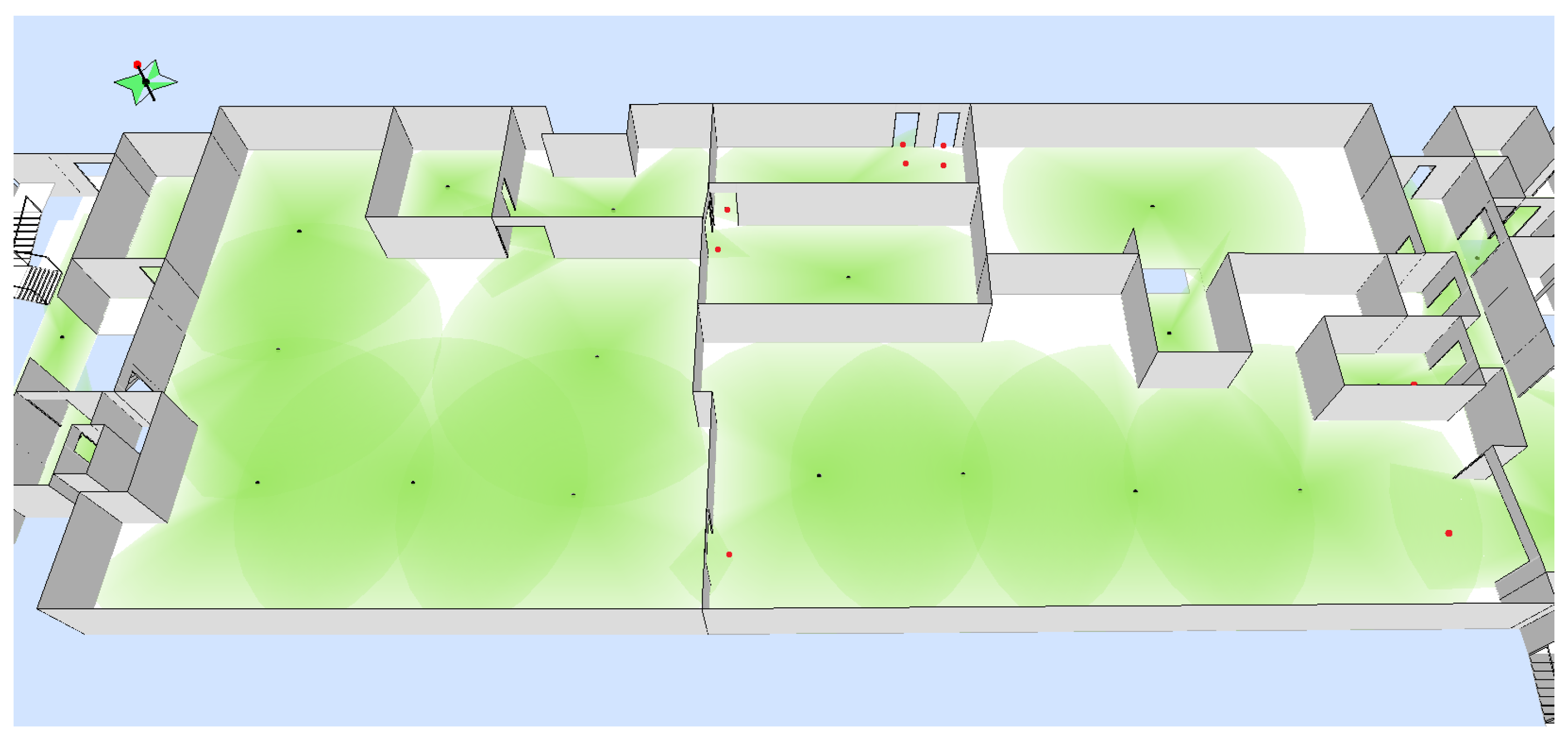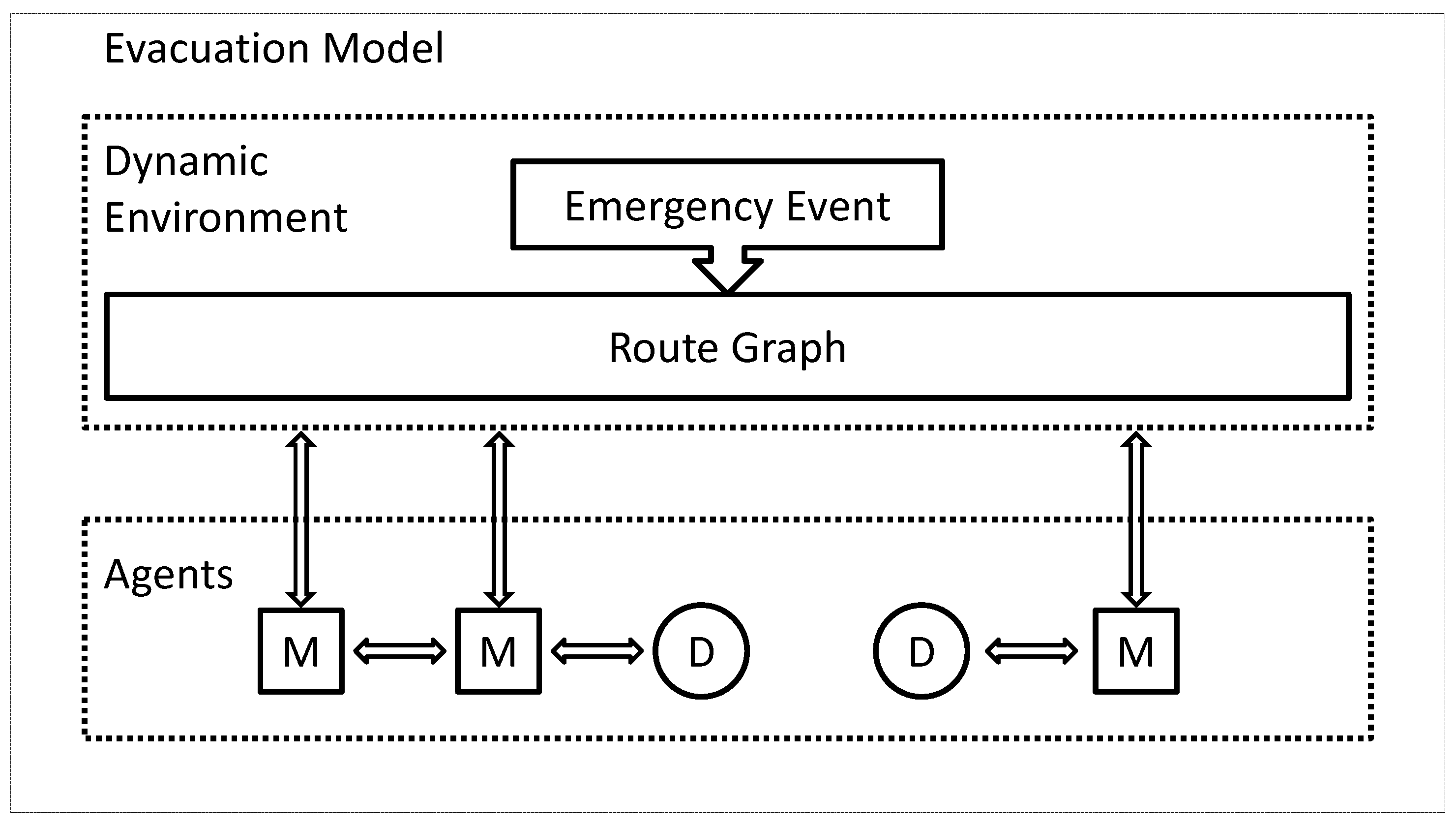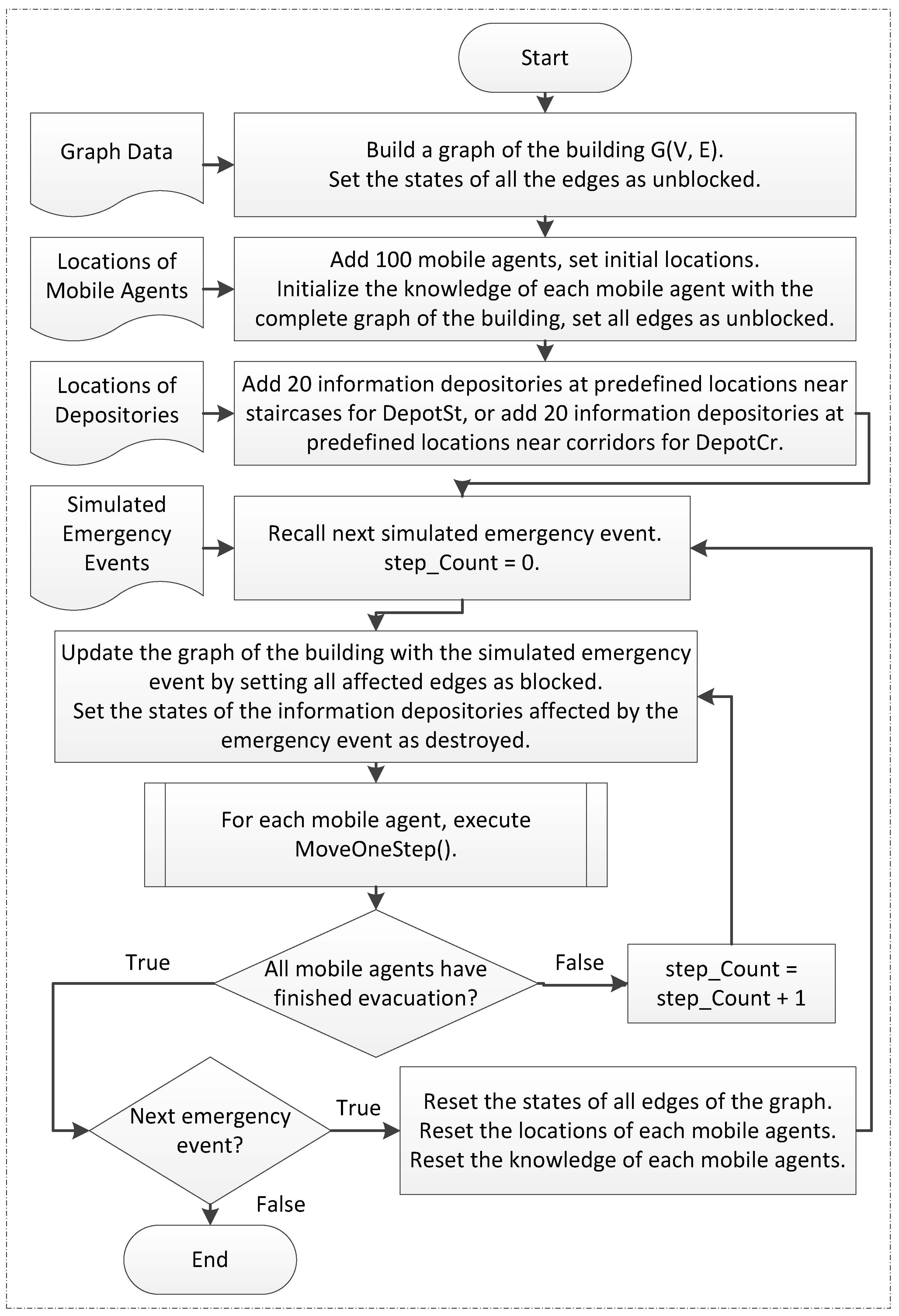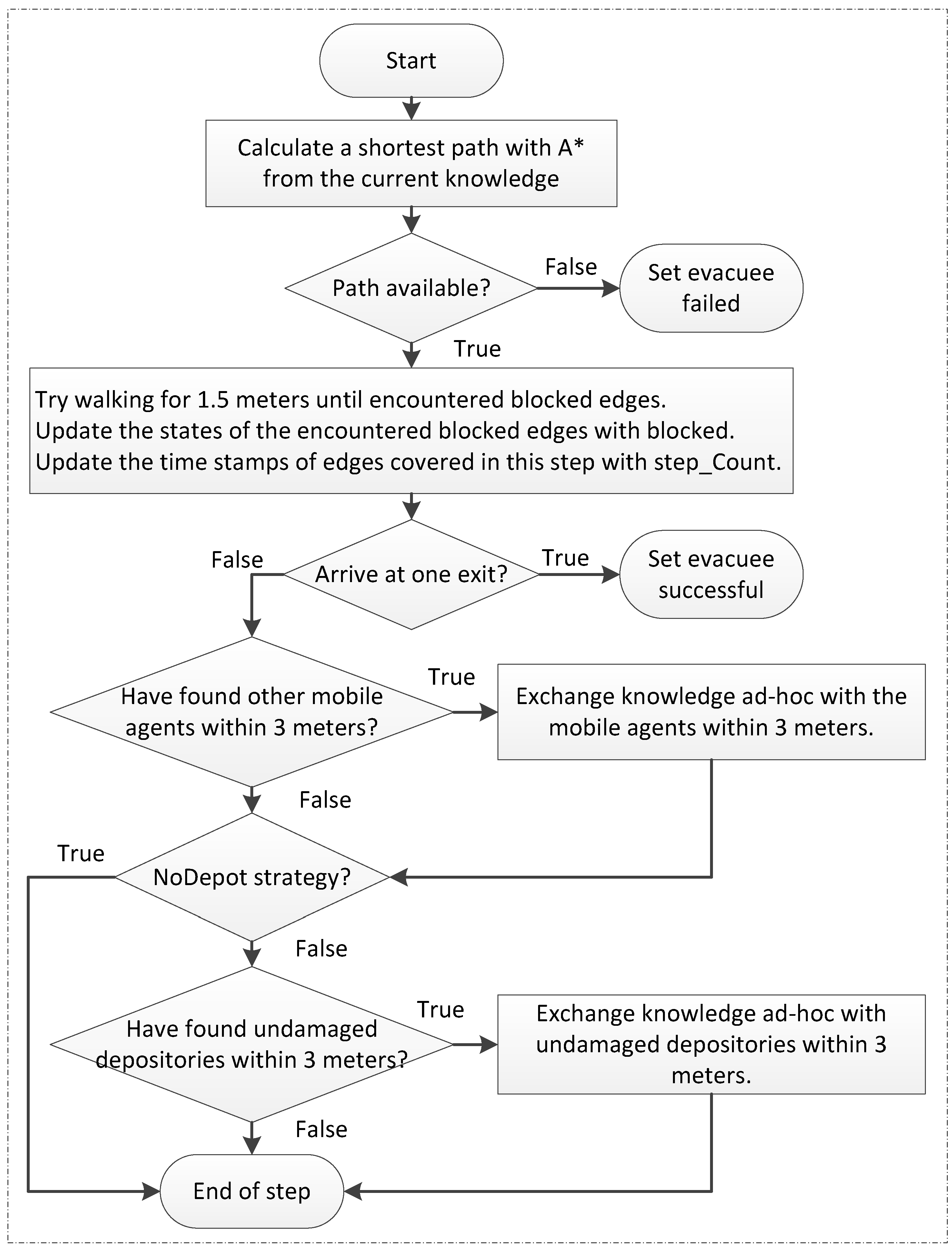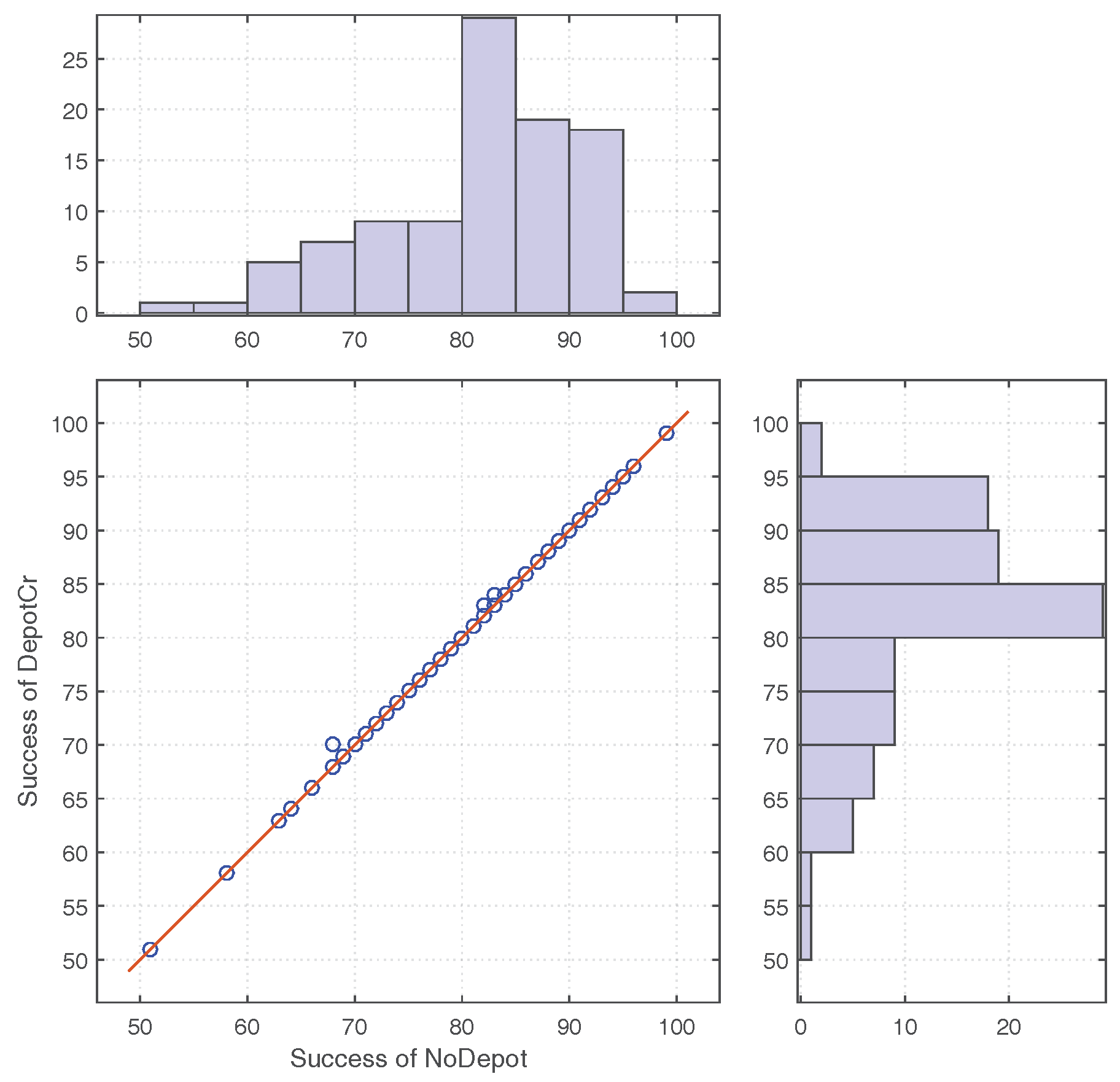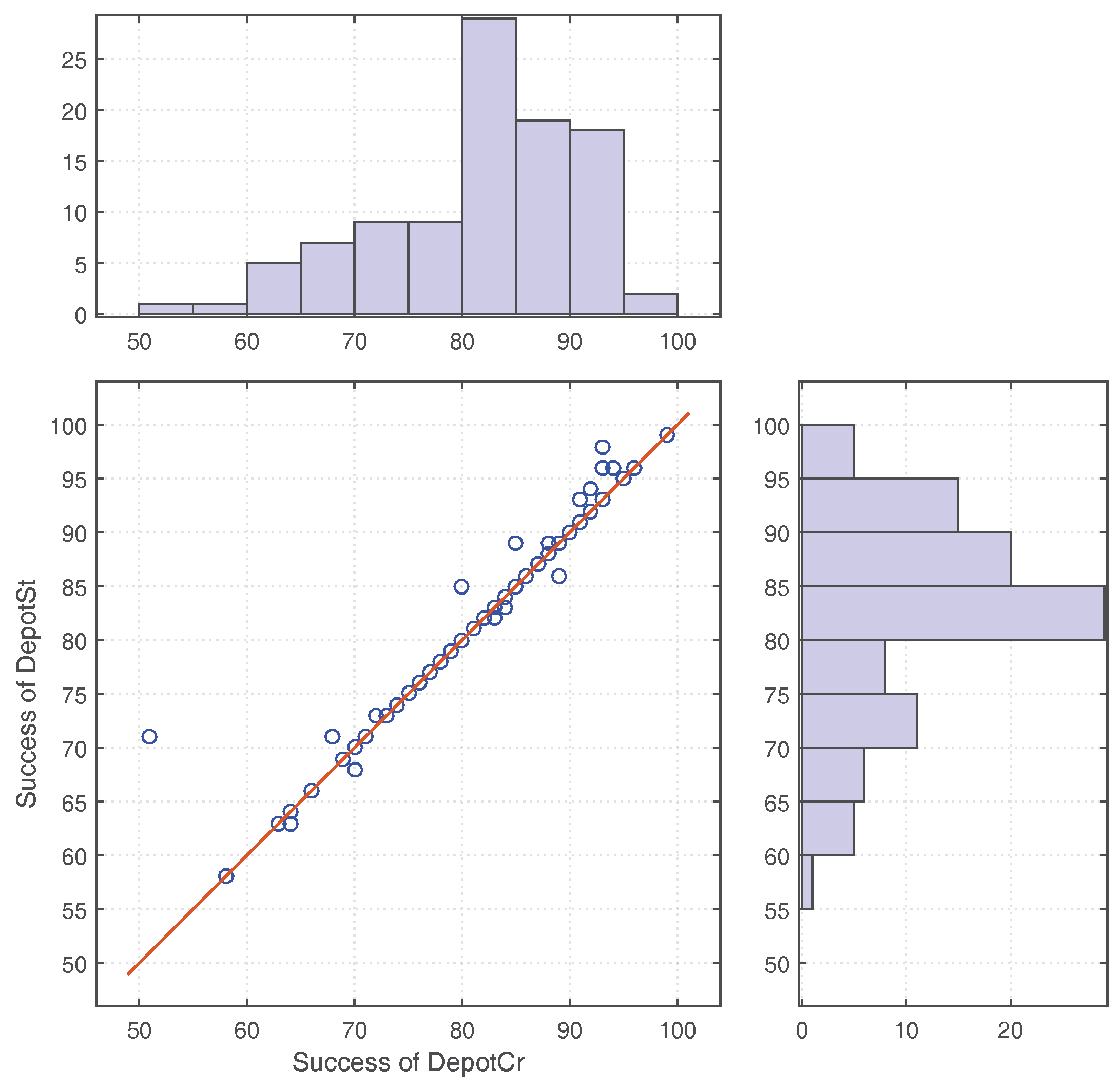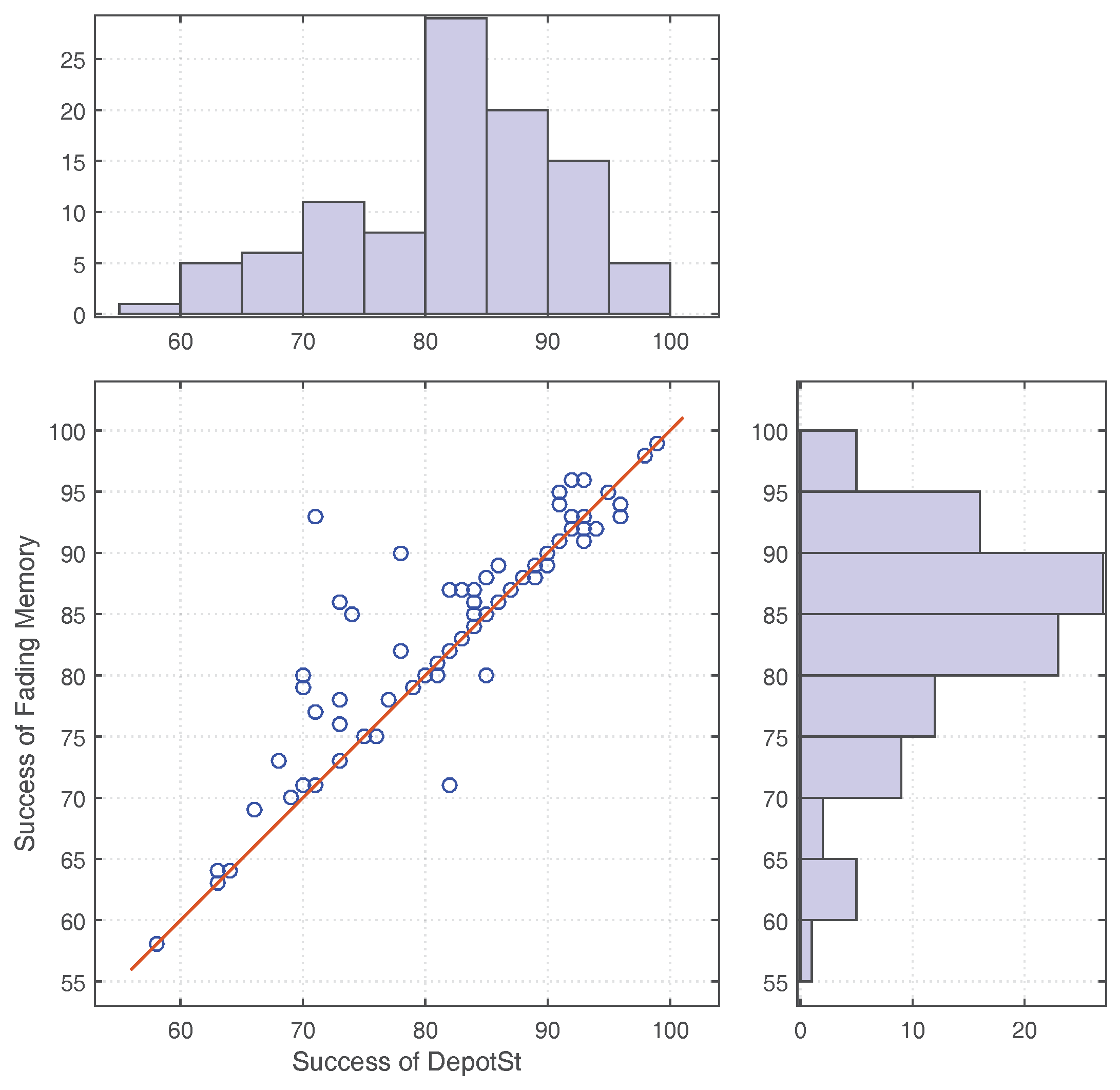Evacuation is the overarching task for disaster management [
3,
7], which generally relocates people from a risky area to safe areas due to emergencies, such as fire, a gas leak, a hurricane, or an earthquake (e.g., [
8,
9]). The area in emergencies can be an office building, a theater, a railway station (e.g., [
10,
11]), a shopping mall, or an urban region (e.g., [
12,
13,
14]). Research on pedestrian and evacuation can be divided into three streams: (a) the study of pedestrian behavior and crowd dynamics, (b) the development of descriptive models to represent pedestrian dynamics as realistically as possible, and (c) the optimization-based method to determine optimal evacuation plans or design solutions [
15]. Most of the research falls under the first two categories.
2.1. Evacuation Models and Crowd Dynamics
Alvear et al. [
16] identified three purposes of evacuation models: (a) performance-based analysis for new and existing buildings in order to evaluate the design and evacuation procedures (e.g., [
17,
18]), (b) forensic analysis to reconstruct historical evacuation processes in order to analyze possible failures and inefficiencies (e.g., [
19]), and (c) management during evacuation procedures (e.g., [
20]). The detailed assessments of the existing modeling approaches and simulation models can be found in the literature [
21,
22,
23,
24].
Evacuation models can be roughly categorized into microscopic models and macroscopic models, which simulate crowd movement in emergency situations with different levels of abstraction. In microscopic models, the evacuating population is considered to be discrete individuals, and collective phenomena emerge from the interactions between individuals. Macroscopic models capture the evacuation situation from a global perspective and represent collective phenomena directly [
21,
22].
Examples of microscopic models are cellular automata models (e.g., [
10,
25,
26,
27,
28,
29,
30,
31]), lattice gas models (e.g., [
32]), social force models (e.g., [
4,
11,
33,
34,
35]), motion planning with velocity obstacles (e.g., [
36,
37]), agent-based models (e.g., [
38,
39,
40]), game theoretic models (e.g., [
41,
42,
43]), approaches based on experiments with animals (e.g., [
44,
45,
46,
47]), and hybrid models (e.g., [
48]). Cellular automata models and lattice gas models partition the space into grids or hexagons. Evacuees are supposed to move from one cell to another. A social force model was first proposed by Helbing and Molnar [
49], describing pedestrians as particles that are subject to forces of attraction and repulsion. Helbing et al. [
4] then developed another social force model to study the collective phenomenon of escape panic, where a mixture of socio-psychological and physical forces was assumed, which includes interaction forces, body force and siding friction force. Velocity obstacle models have been originally developed for robot motion planning. They assume that other robots in the environment maintain their current velocity and thus may define velocity obstacles; such models enable a robot to plan for collision avoidance. Agent-based models describe the evacuation system by simulating each evacuee (or a household [
40]) as an autonomous agent with certain behavior and situated in an environment, and studying the emergent system behavior. In contrast, approaches based on experiments with animals study escape dynamics with real biological agents such as mice [
44] or ants [
45,
46,
47]. Hybrid models combine the previously mentioned microscopic models to benefit from their advantages and to avoid their drawbacks.
In contrast to microscopic models describing the crowds as discrete individuals, macroscopic models treat the crowd as a continuous medium characterized by averaged quantities such as density and velocity [
50,
51]. Fluid dynamic models are the most recognized macroscopic models [
52,
53], which use the analogy of fluid dynamics to describe the crowd flow in the form of partial differential equations [
54]. Fluid-dynamic models and social force models are continuous in space and time, compared to cellular automata models and lattice gas models, where space and time are discrete [
22]. Agent-based models can have both continuous and discrete representations in space and time.
Typical phenomena that can be reproduced in simulations include kin behavior, arching, effect of obstacles, jamming, friction effects, clogging, “freezing by heating", “faster-is-slower", counterflow, choking flow, mass behavior, pushing behavior, panic propagation, impatience, repulsion behavior, competitive behavior, queuing behavior, and herding behavior [
22]. Zheng et al. [
22] identified two reasons that may cause people being injured or killed during evacuations: either due to failing to evacuate timely, or due to the crowd’s behavior such as shuffling, pushing, crushing, and trampling. Sivers et al. [
19] argued that most models for evacuation dynamics consider individuals as particles, so they added social identity to pedestrian simulation. They take helping others as an example to investigate whether psychological models and computer models of pedestrian motion can be combined so that simulation results correspond to observations from crowd psychology. Davidich et al. [
10] found that standing pedestrians affect crowd dynamics strongly and should be considered when designing critical infrastructures such as railway stations. Kneidl et al. [
48] developed a hybrid model which combines a dynamic navigation field with a navigation graph. Space and time are discretized using cellular automata, which act as the underlying grid for constructing the navigation field. The dynamic navigation field employs the analogy of an expanding wave which estimates the travel times of pedestrians traveling between an origin and a given destination considering congestions. Such a dynamic navigation field allows evacuees (a) to follow a direction which is subject to minimization of estimated travel times, and (b) to steer around congestions even when the congestions are not visible from their actual position. However, Kneidl et al. [
48] aimed to provide a realistic simulation of crowd dynamics rather than optimizing evacuation paths, so they also added a navigation graph constructed on top of the scenarios’ geometry which acts as a visibility graph to help distinguish between visible and invisible areas.
In contrast to building evacuation, other research deals with optimizing traffic during evacuations on an urban scale [
25,
55]. So and Daganzo [
25] proposed a decentralized strategy that evacuated the maximum number of people at all times. Feng and Miller-Hooks [
20] proposed a network optimization-based methodology to support crowd movement during large public gatherings held in venues such as complex buildings, transportation stations, football stadiums, and commercial malls. Yin et al. [
40] presented an agent-based travel demand modeling system to generate household activity-travel plans for hurricane evacuation simulation, in which each agent represented a household. They considered the ultimate evacuation trips of a household as the result of a series of demands and the thereafter decisions, such as whether to evacuate, when, to where, by which mode, as well as pre-evacuation preparation activities such as purchasing fuel and food, or family gathering. Another model addressing the simulation of pre-evacuation behavior has been studied by Lovreglio et al. [
56], which adopted Random Utility Theory. Compared with indoor evacuation which involves pedestrians, evacuation planning in urban areas involves different tasks: such as deciding shelter locations, routing for public transport and for individual traffic simultaneously [
13]. A review of highway-based evacuation modeling and simulation has been provided as well [
57].
This paper focuses on simulating the heterogeneous characters of each evacuee and their interactions by using an agent-based model. Each evacuee acts as an autonomous agent which independently explores the environment and acquires different knowledge. In particular, this paper aims to investigate optimal evacuation strategies when the density of evacuees is very low and chances for encounters are rare, thus crowd behavior has been neglected in all the simulations.
2.2. Evacuation Optimization
Compared with evacuation models and crowd dynamics, evacuation optimization has received less attention from researchers. A recent review of optimization models for evacuation problems has been provided [
15].
The purpose of evacuation optimization is to improve the evacuation process, aiming at two objectives: reducing the number of deaths and accelerating the evacuation process [
7]. Research efforts for evacuation optimization fall into two categories: either to improve the evacuation process by improving the environmental factors (e.g., optimizing the room structures, finding the optimal number, width and placement of doors), or by improving the path choice of evacuees [
58].
Optimization models gravitate to graphs to represent the paths available to pedestrian evacuees [
59,
60]. A graph is defined by a set of nodes representing rooms or decision points, and edges representing doors, corridors, or other paths connecting the spaces represented by nodes [
61]. Edges are associated with weights, which can be the distance between the connected nodes or the time required to travel between the connected nodes. A time-expanded graph includes a graph and states of nodes and edges at different time steps [
59,
62]. Optimization of path choices has been studied either by optimizing the flow of pedestrians (or vehicles) based on evacuation graph, or by finding evacuation paths with minimum cost algorithms such as Dijkstra’s, A*, Ant Colony Optimization, D*, or D* Lite.
For path planning, evacuees may either have the global knowledge of the graph or only have a limited view of the graph. All the knowledge is time stamped and may have become out of date due to the evolution of the disaster, thus introducing uncertainty to the knowledge. Zhao and Winter [
2] addressed the uncertainty of knowledge by developing a fading memory model which trusted less the older knowledge. They found that the fading memory model generally improved the evacuation process. However, such a model also poses a risk of devaluing knowledge that is still valid. Another research that considers the impact of the dynamics of disasters on the evacuation process was conducted by Tan et al. [
63]. They considered both the stationary environment during a normal situation and the predictable spatial change caused by the activated fire safety facilities during emergency situations, such as a fire rolling shutter that would be shut off during emergency situations.
Wang et al. [
1] and Wang et al. [
62] addressed the evacuation optimization problem by suggesting a centralized evacuation framework incorporating multiple sensors and mobile phones. Such a centralized system carries out computations on a central server and makes decisions based on real-time awareness of the state of the environment, thus producing optimal evacuation paths. However, such centralized systems share a common shortcoming: They require system infrastructure and expect that their infrastructure is not affected by the disaster.
In contrast to evacuation models aiming for realistic simulation of crowd dynamics, evacuation optimization aims to investigate efficient evacuation strategies, which is to be addressed in this paper. In particular, this paper focuses on evacuation strategies in a decentralized manner. Further, this paper prioritizes the number of successful evacuees over minimizing evacuation times, since not all the evacuees are guaranteed to be successfully evacuated.
2.3. Decentralized Evacuation
Advances in technology such as sensors and smartphones make decentralized spatial computing possible. Existing sensors can detect acoustic, chemical, electromagnetic, optical, thermal, or mechanical stimuli, and convert such environmental stimuli into digital signals to be processed by a computer [
64]. Such sensors can measure environmental data such as humidity,
concentration, temperature, or even location [
65]. A number of these sensors can be found on-board of smartphones, and thus, smartphones can be considered a node in a mobile sensor network. A sensor node has a microcontroller for computing, a wireless radio for communication, and one or more sensors for capturing data about its environment. Mobile sensor networks are examples of decentralized systems. A decentralized system is a special case of a distributed system where no single component knows the entire system state and each node in a decentralized system acts independently and autonomously. In general, decentralized spatial computing is advantageous over centralized spatial computing in six aspects: energy constraints, information overload, scalability, sensor/actuator networks, latency, and information privacy [
64].
Richter et al. [
3] proposed a decentralized system for collaborative evacuation. This system utilizes smartphones with their sensors and their capacity for peer-to-peer communication where computation is performed directly on the devices held by evacuees and guidance is provided by a mobile service. The advantage of peer-communication and -collaboration correlates positively with the density of evacuees in the environment: The more evacuees exist in a certain environment, the more opportunity exists for exchanging knowledge. However, a larger number of evacuees also implies an increased risk of congestions [
58]. Similar work has been done by Fujihara and Miwa [
66]. They considered the opportunistic communication of mobile nodes in Mobile Opportunistic Networks (MONs), and assumed also a navigation service. Evacuees share disaster information by opportunistic encounter and short-range wireless communication. In their scenario the disaster information is finally gathered by a database server in the refuge and forwarded out of the disaster area by delay tolerant network technologies such as satellite-based communications. Komatsu et al. [
67] also introduced cooperation between evacuees with mobile sensor nodes. Each mobile node senses the environment and tries to navigate its evacuee by presenting an evacuation route. The mobile node estimates a road segment as blocked when it detects the difference between a recommended route and actual evacuation behavior. Then it recalculates an alternative evacuation route, which does not include the blocked road segments discovered. They focus specifically on reducing the network load. Iizuka et al. [
68] presented a method for decentralized evacuation, which considers evacuation as a distributed constraint optimization problem and estimates the location of evacuees so as to relieve congestion.
Due to the fundamental property of opportunistic communication, all the wireless mobile sensor networks share a shortcoming that the effects of opportunistic communication become weaker when the number of users in the network is smaller. None of the previous work has addressed this issue. Thus, improving decentralized evacuation management for less occupied buildings is the object to be addressed in this paper.
While static sensor networks can detect the extent of phenomena such as fires or concentrations of pollutants, and can delineate the boundaries of such regions, low-density in situ sensor networks may not suffice to estimate the boundaries, especially in evacuation situations where the sensor nodes are outside of these hazardous regions. Brink [
69] suggest adding mobile sensors with an intelligent and adaptive sampling strategy to collect the missing information for monitoring the boundaries of highly dynamic phenomena such as plumes. In contrast, this paper will suggest static depositories at strategic locations that collect the knowledge acquired by the smartphones of evacuees passing by, merging data over time.


